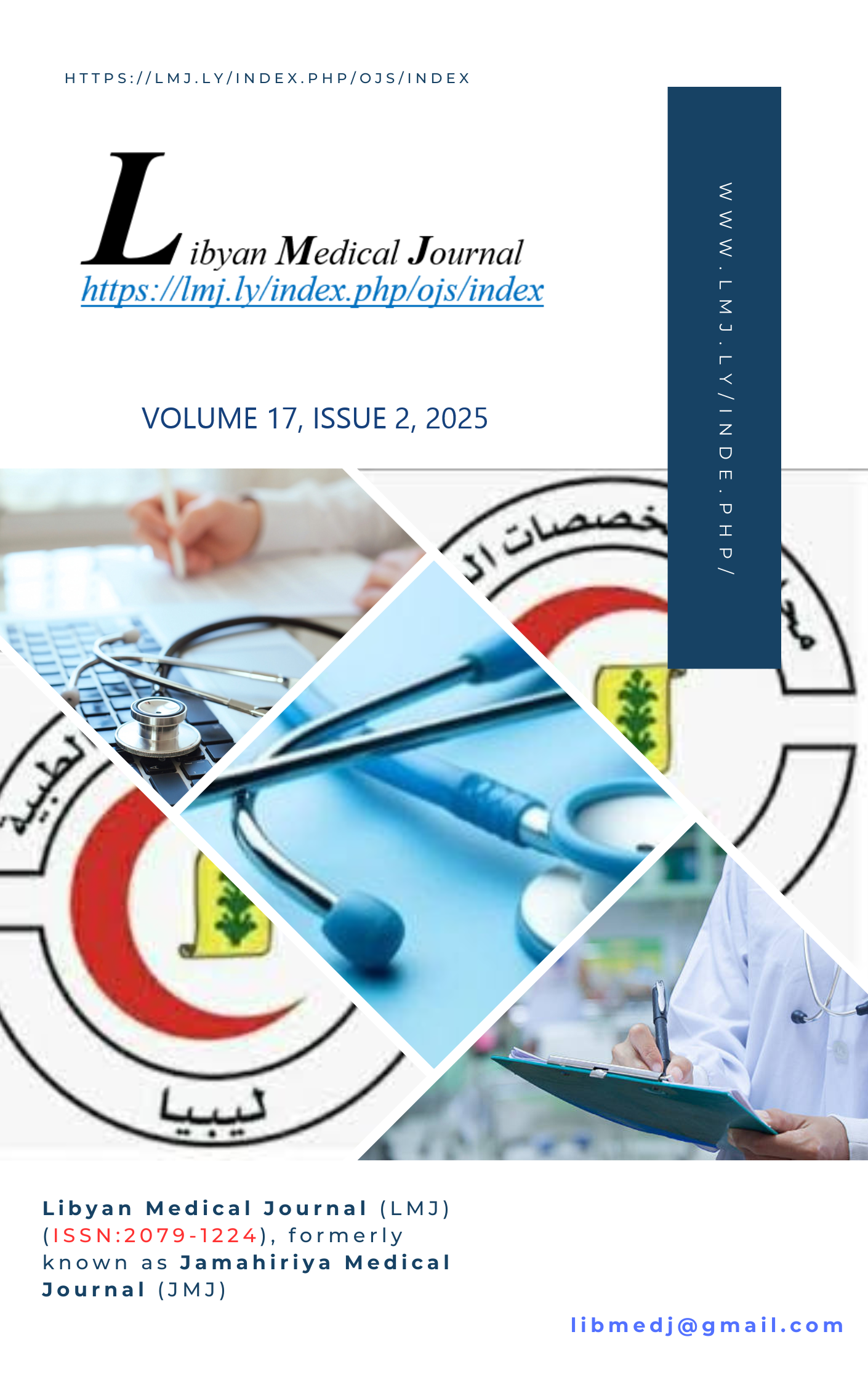Risk Factors of Early Menopause: A Descriptive Study
DOI:
https://doi.org/10.69667/lmj.2517210Keywords:
Risk Factors, Early Menopause, Libya.Abstract
Menopause is an inevitable physical change experienced by women during the aging process. As the production of female hormones decreases and ovulation stops alongside the aging of the ovaries, regular menstruation disappears. Although menopause itself is not a pathological condition, menopausal transition is accompanied by negative physical changes. With the increase in life expectancy, the proportion of postmenopausal life also increases. Thus, the impact of menopause on women’s health has become more significant from both clinical and health perspectives. This study was conducted to identify the risk factors associated with early menopause in women in Tripoli. This was a retrospective case series study; it was conducted in Aljala maternity hospital, Tripoli, Libya, during the year 2017. Three hundred and thirty women who were diagnosed as cases of early menopause were randomly selected from the hospital files and from interviews with the women who attend the gynecology clinic. The following data were obtained from the files and the women: the age of menarche, menstrual cycle, marital state, education level, working status, smoking, parity, history of oral contraceptive, BMI, and history of pelvic surgery. Regarding the age of menarche, the mean age of menarche was 12 ± 1.14 years. The majority of the women had their menarche at age below 13 years (70.3%). Most of the women in the study had regular menstrual cycles (85.5%). Most of the women were educated, not working, and married. The current study showed that about 26% of the women who had early menopause had a history of passive smoking. Regarding the obstetric history, most of the women were multiparous, and most of them did not use contraceptive pills. The study concluded that the majority of the women who had early menopause had menarche at an early age, had regular cycles, were married, educated, not working, multiparous, and did not use oral contraceptives. Other factors, such as smoking, BMI, and history of pelvic surgery, showed lower percentages.
References
van Noord PA, Dubas JS, Dorland M, Boersma H, de Velde E. Age at natural menopause in a population-based screening cohort: the role of menarche, fecundity, and lifestyle factors. Fertil Steril 1997;68:95–102.
Bachelot A, Rouxel A, Massin N, Dulon J, Courtillot C, Matuchansky C, et al. Phenotyping and genetic studies of 357 consecutive patients presenting with premature ovarian failure. Eur J Endocrinol 2009;161:179–87.
Nelson LM. Clinical practice. Primary ovarian insufficiency. N Engl J Med 2009;360:606–14.
Coulam CB, Adamson SC, Annegers JF. Incidence of premature gonadal failure. Fertil Steril 1986;67:604–606.
Panay N, Fenton A. Premature ovarian failure: a growing concern. Climacteric 2008;11:1–3.
Nori W, Hussein Z, Salman A. Premature Ovarian Insufficiency; The Conventional and non-Conventional Fertility Options. AlQalam Journal of Medical and Applied Sciences. 2022 Jan 4:43-7.
Panay N, Kalu E. Management of premature ovarian failure. Best Pract Res Clin Obstet Gynaecol 2009;23:129–40.
Nelson LM, Anasti JN, Kimzey LM, Defensor RA, Lipetz KJ, White BJ, et al. Development of luteinized graafian follicles in patients with karyotypically normal spontaneous premature ovarian failure. J Clin Endocrinol Metab 1994;79:1470–5.
van Kasteren YM, Schoemaker J. Premature ovarian failure: a systematic review on therapeutic interventions to restore ovarian function and achieve pregnancy. Hum Reprod Update 1999;5:483–92.
Jacobsen, B.K. and E. Lund, Level of education, use of oral contraceptives and reproductive factors: the Tromso Study. Int J Epidemiol, 1990. 19(4): p. 967-70.
Weismiller DG. The perimenopause and menopause experience. Clin Fam Prac 2002;4(1):1-12
Sherma S. Defining the menopausal transition. Am J Med 2005;118(12B):3S-7S
Cramer DW, Xu H. Predicting age at menopause. Maturitas 1996;23:319–26.
Cramer DW, Xu H, Harlow BL. Does ‘incessant’ ovula- tion increase risk for early menopause? Am J Obstet Gynecol 1995; 172: 5688573.
Whelan EA, Sandler DP, McConnaughey DR, Weinberg CR. Menstrual and reproductive characteristics and age at natural menopause. Am J Epidemiol 1990;131:625–32
Stanford JL, Hartge P, Brinton LA, et aL Factors influencing the age at natural menopause. J Chronic Dis 1987;40:995-1002.
Leidy Sievert L, Waddle D, Canali K. Marital status and age at natural menopause: Considering pheromonal influence. American Journal of Human Biology. 2001;13(4):479-485.
Cramer DW, Harlow BL, Xu H, Fraer C, Barbieri R. Cross-sectional and case-controlled analyses of the association between smoking and early menopause. Maturitas. 1995;22(2):79–87
Yang HJ, Suh PS, Kim SJ, Lee SY. Effects of Smoking on Menopausal Age: Results From the Korea National Health and Nutrition Examination Survey, 2007 to 2012. Journal of Preventive Medicine and Public Health. 2015;48(4):216-224.
Jeune B. Parity and age at menopause in a Danish sample. Mauritas 1986;8:359–65.
52. Beser E, Aydemir V, Bozkaya H. Body mass index and age at natural menopause. Gynecol Obstet Invest 1994;37:40– 2.
Bromberger JT, Matthews KA, Kuller LH, Wing RR, Neilahn EN, Plantinga P. Prospective study of the determinants of age at menopause. Am J Epidemiol 1997;145:124-33.











